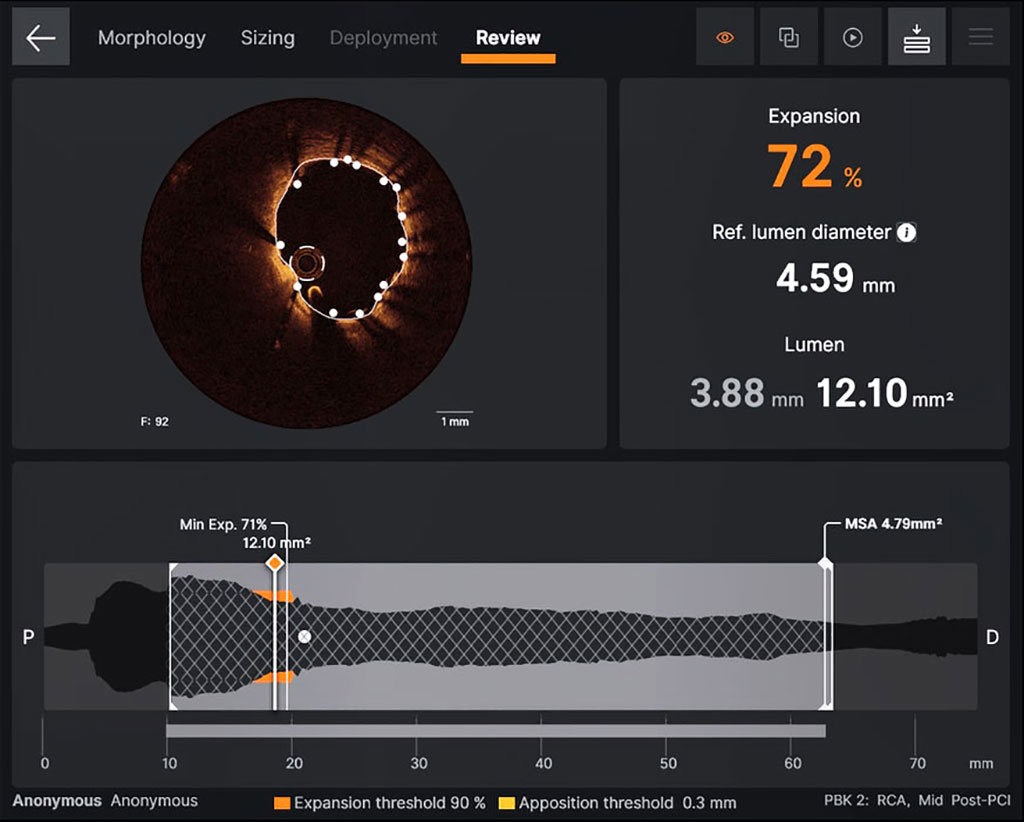OCT Intravascular Imaging Improves Stenting Procedure Outcomes
Posted on 04 Sep 2023
Individuals diagnosed with coronary artery disease—a condition marked by the buildup of plaque within arteries leading to chest pain, shortness of breath, and heart attacks—often undergo percutaneous coronary intervention (PCI). This non-surgical procedure involves interventional cardiologists employing a catheter to position stents within blocked coronary arteries, thereby restoring blood flow. The most prevalent guidance method for PCI is angiography, which employs X-rays and a specialized dye (contrast material) to visualize blood flow through heart arteries and highlight any blockages. However, angiography has its limitations. It struggles to accurately determine artery size and plaque composition, and is suboptimal in identifying issues like stent expansion post-PCI and other complications that impact the procedure's effectiveness and safety. Intravascular ultrasound (IVUS) is an alternative technique offering a more precise and specific view of coronary arteries. Although studies confirm that IVUS-guided PCI surpasses angiography-guided PCI, leading to reduced cardiovascular events, its usage remains limited due to challenges in image interpretation.
A more recent technique is optical coherence tomography (OCT), which employs light, rather than sound, to create images of blockages. OCT images exhibit superior resolution, accuracy, and detail compared to IVUS, with easier interpretability. Despite these advantages, OCT is only applied in 3% of PCI cases, partially due to limited study data. The aim of this new trial is to alter this landscape. Now, a new study has found that using OCT to guide stent implantation during PCI can enhance safety and yield better outcomes for heart disease patients than relying solely on angiography. These findings are from the ILUMIEN IV: OPTIMAL PCI study which is the largest clinical trial of its kind comparing the two methods for this procedure.

The ILUMIEN IV: OPTIMAL PCI trial randomized 2,487 patients to OCT-guided PCI using a device manufactured by Abbott (Abbott Park, IL, USA) and angiography-guided PCI. The trial was conducted between May 2018 and December 2020 across 80 centers in 18 countries, with patients unaware of their assigned guided procedure. Researchers assessed post-PCI dimensions of the stented area since stent re-narrowing over time can necessitate repeat revascularization procedures. Notably, the OCT group displayed a significantly larger stent area immediately after the procedure compared to the angiography-guided group—a .36mm2 increase. OCT guidance also correlated with fewer procedural complications compared to angiography guidance.
Additionally, the study examined target lesion failure (TLF), a combination of cardiac death, target-vessel myocardial infarction, or ischemia-driven target-vessel revascularization. Two years post-procedure, 88 patients in the OCT group experienced TLF, in contrast to 99 patients in the angiography group. Although this difference did not reach statistical significance, the study delved further into stent thrombosis rates, a severe PCI complication. Within two years of PCI, six patients in the OCT group experienced stent thrombosis, while 17 patients in the angiography group encountered this issue—showing OCT's 65% reduction in such instances. Importantly, 96% of patients experiencing stent thrombosis in the trial subsequently faced death or myocardial infarction, highlighting the importance of preventing such events.
“The ILUMIEN IV trial demonstrated that OCT-guided PCI compared with angiography-guided PCI improves stent implantation results and the safety of the procedure, with less stent thrombosis, the most devastating complication of stenting,” said senior author Gregg W. Stone, MD. “However, while there were numerically fewer cardiac deaths and myocardial infarctions (MIs) in the OCT group, the differences between groups in the primary composite outcome of cardiac death or MIs or repeat revascularization related to the treated vessel was not significant.”
Related Links:
Abbott














